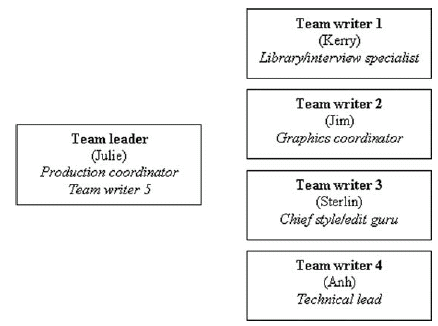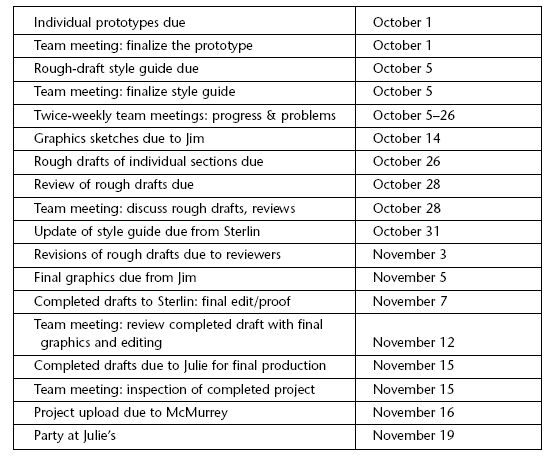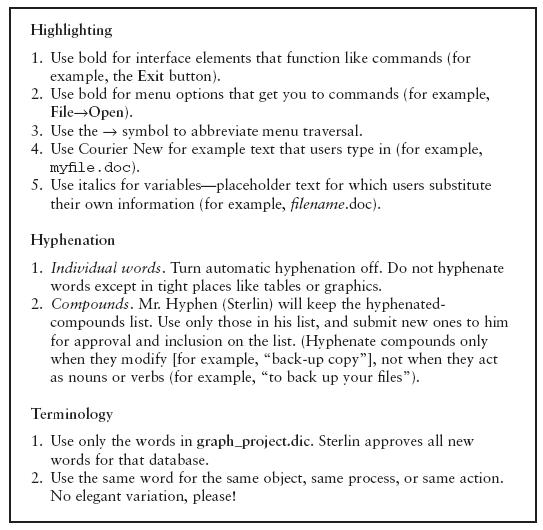Assembling the Team
| Writing Team 1 | |
| Project: | A report on current cloaking technologies |
| Team members | Backgrounds, skills, interests |
| Shawn S. | Electrical engineering major, currently doing basic office-management chores at a law firm |
| Tracey K. | Senior English major, hoping this course helps with employment prospects |
| Sanjiv Gupta | Computer science major, currently doing computer graphics at a software development shop |
| Jeon Chang Yeon | Soon-to-be electrical engineering major, still developing English language skills |
| Alice B. | Undeclared major with a nontechnical focus, possibly in the wrong course, no stated skills |
Planning the Project
Once you’ve assembled your writing team, most of the work is the same as it would be if you were writing by yourself—except that each phase is a team effort. Specifically, meet with your team to decide or plan the following:
Planning Stages
- Analyze the writing assignment.
- Pick a topic.
- Define the audience, purpose, and writing situation.
- Brainstorm and narrow the topic.
- Create an outline.
- Plan the information search (for books, articles, etc., in the library).
- Plan a system for taking notes from information sources.
- Plan any graphics you’d like to see in your writing project.
- Agree on style and format questions (see the following discussion).
- Develop a work schedule for the project and divide the responsibilities (see the following).
Capture your team’s profiles and decisions in a simple team-planning document. It can contain the key dates in the team schedule, a tentative outline of the document to be team-produced, formatting agreements, individual writer assignments, word-choice preferences, and so on. Below, a by-laws document is mentioned. That can be incorporated into the team plan as well.
Much of the work in a team-writing project must be done by individual team members on their own. However, if your team decides to divide up the work for the writing project, try for at least these minimum guidelines:
- Have each team member responsible for the writing of one major section of the paper.
- Have each team member responsible for locating, reading, and taking notes on an equal part of the information sources.
You may want to do some of the work for the project that could be done as a team first independently. For example, brainstorming, narrowing, and especially outlining should be done first by each team member on their own; then, get together and compare notes. Keep in mind how group dynamics can unknowingly suppress certain ideas and how less assertive team members might be reluctant to contribute their valuable ideas in the group context.
After you’ve divided up the work for the project, write a formal chart and distribute it to all the members.

Scheduling the Project and Balancing the Workload
Early in your team writing project, set up a schedule of key dates. This schedule will enable you and your team members to make steady, organized progress and complete the project on time. As shown in the example schedule below, include not only completion dates for key phases of the project but also meeting dates and the subject and purpose of those meetings. Notice these details about that schedule:
- Several meetings are scheduled in which members discuss the information they are finding or are not finding. (One team member may have information another member is looking everywhere for.)
- Several meetings are scheduled to review the project details, specifically the topic, audience, purpose, situation, and outline. As you learn more about the topic and become more settled in the project, your team may want to change some of these details or make them more specific.
- Several rough drafts are scheduled. Team members peer-review each other’s drafts of individual sections at least twice, the second time to see if the recommended changes have worked. Once the complete draft is put together, it, too, is reviewed twice.

Anticipating Problems and Creating Team By-laws
You can think ahead to resolve typical problems that can arise in a team project and document your team’s agreements about these matters in a by-laws document:
Workload Imbalance
- When you work as a team, there is always the chance that one of the team members, for whatever reason, may have more or less than a fair share of the workload. Therefore, it’s important to find a way to keep track of what each team member is doing. A good way to do that is to have individual team members keep a journal or log of what kind of work they do and how much time they spend doing it.
- Both during and at the end of the project, if there are any problems, the journal should make the issue very clear and enable a more equitable balancing of the workload. At the end of the project, team members can add up their hours spent on the project; if anyone has spent a little more than their share of time working, the other members can make up for it by buying them dinner or another similar reward. Similarly, as you reach the end of the project, if it’s clear from the journals that one team member’s work responsibilities turned out, through no fault of their own, to be smaller than those of the others, they can make up for it by doing more of the finish-up work such as typing, proofing, or copying.
Team members without relevant skills
- As you can see in the example description of team members’ skills above, one member has no relevant skills with which to contribute to the project. Sometimes, that’s just an indication of that person’s anxiety or lack of interest in engaging in a group project. Of course, each team member in a writing course should contribute a fair share of the writing for a project. However, there are plenty of tasks that do not require technical knowledge, formatting skills, or a sharp editorial eye, for example, typing up and distributing the team plan, the by-laws, minutes of team meetings, and reminding team members of due dates and scheduled meetings. In fact, except for the anxiety or lack of interest, the self-professed unskilled team member might make the best team leader!
Disappearing team members.
- If your team is unfortunate enough to have an irresponsible member who simply vanishes, have a plan for what to do about that and document it in your team by-laws. One obvious solution is to kick the team member off the team and inform the instructor if it’s a writing course or the next level of management if it’s a nonacademic organization.
Seemingly entrenched team-member disagreements
- It is amazing how vehemently team members can disagree on aspects of a team-writing project. To prepare for this possibility, have a plan written in your team by-laws that addresses how team members can resolve these matters. Should they be put to a vote? Should you “escalate” the matter to a neutral or higher-level party?
Radically inconsistent writing styles and format
- Because the individual sections will be written by different writers who are apt to have different writing styles, set up a style guide in which your team members list their agreements on how things are to be handled in the paper as a whole. These agreements can range from the high level, such as whether to have a background section, all the way down to picky details, such as when to use italics or bold and whether it is “click” or “click on.” See the excerpt from a project style sheet in the following.
- Before you and your team members write the first rough draft, you can’t expect to anticipate every possible difference in style and format. Therefore, plan to update this style sheet when you review the rough draft of individual sections and especially when the team reviews the complete draft.

The items listed in Figure 4 represent agreements team writers have made to ensure the consistency of their paper.
Reviewing Drafts and Finishing
Try to schedule as many reviews of your team’s written work as possible. You can meet to discuss each other’s rough drafts of individual sections and the complete paper. When you do meet, follow the suggestions for peer editing.
A critical stage in team-writing a paper comes when you put together into one complete draft those individual sections written by different team members. It’s then that you’ll probably see how different the tone, treatment, and style of each section is. You must, as a group, find a way to revise and edit the complete rough draft to make it read consistently so that it won’t be so obviously written by three or four different people.
When you’ve finished reviewing and revising, it’s time for the finish-up work to get the draft ready to hand in. That work is the same as it would be if you were writing the paper on your own, only in this case, the workloads can be divided up.
Works Cited
“Strategies for Peer Reviewing and Team Writing” in Online Technical Writing by David McMurrey, which is is licensed under a CC BY-SA 4.0 International License.

